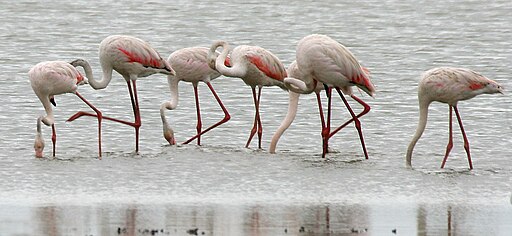Welcome to our second Flamingo Friday!! We have been enjoying learning more about flamingos and hope you are too! Today we are sharing a non-fiction book with you and something we learned from it.
We have been reading several flamingo books. We will share each one with you eventually. If you missed the first one which was the wordless Flora and the Flamingo, you can check it out here. Today we are going to share Wild Flamingos by Bruce McMillan.
Now before I begin with what we did with this book, I would like to point out the wonderful picture on the cover. I love it because you can see the black flying feathers of the flamingo. Did you know they had black feathers?
| Source |
This book focuses on flamingos on the Caribbean island of Bonaire. The species of flamingo are the Greater Flamingos which are the largest of the flamingos. Their average height is five to five and a half feet tall. Their average weight is eight pounds for the males (who are taller) and six and a half for the females. Their populations is estimated to be half of the number there was before Europeans first came to the Americas. Bonaire protects the flamingos and their breeding ground. There is concern about the development of their feeding area in Venezuela though. The book goes through the lives of a flamingo from birth until adulthood and returning to nest again.
Now many people know that flamingos get their color from the food they eat. They eat small shellfish and immature brine flies at both the free-swimming larvae and intermediate chrysalid stages. All of these animals eat aquatic plants and bacteria that contain the same chemicals that make carrots orange. So for a simple craft we decided to paint with carrots. We experimented with a few different methods. First we took a carrot and tried to use it as a paintbrush. I gave Hazel pictures to color that I printed out. The first one came from Lucy Learns.
This method worked all right, but was not great. Here is our end result:
Our other method involved grating the carrot and then placing the pieces on the picture and hammering them into the picture.
We put a piece of paper on the bottom and top. I think we actually flipped it so the picture was on top. Immediately afterward the picture looked like this:
This coloring page came from The Color. Then after it dried a bit, I picked off some of the carrot flakes and we got this:
We also bought a can of carrots to try to paint with, but we haven't had time yet.
The other interesting thing I learned about flamingos is how they eat. The flamingos always eat with their heads upside down. Their top jaw is hinged and moves like our lower jaws. They filter-feed and are able to separate the food from water and mud. Their bills are lined with hair like teeth that filter the food. Sometimes you will see a flamingo move its feet and bill around before eating. This is to stir up the mud a bit and get the food in the water since it is easier to filter water than mud.
So that is our lesson flamingos this Flamingo Friday!! I hope you enjoyed it!! And definitely check out Wild Flamingos by Bruce McMillan for more about the Greater Flamingos in Bonaire!











Wow, I learned a lot about flamingos from this post. It's an interesting idea to paint with grated carrots :)
ReplyDelete